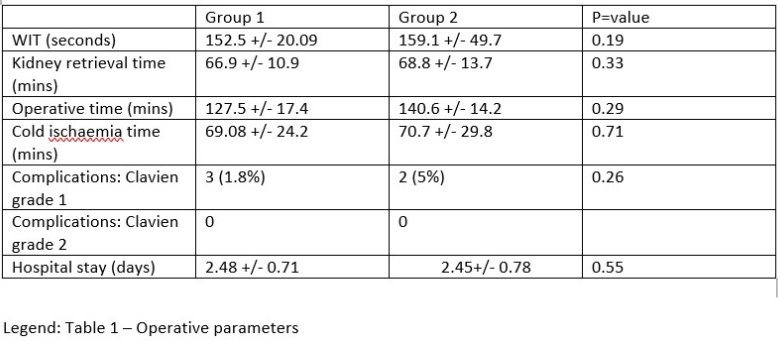Donor and recipient outcomes of retroperitoneal laparoscopic donor nephrectomy in obese versus non obese donors: A prospective study
Naresh Garg1, Syed J. Rizvi1, Sajni Khemchandani1, Pranjal R. Modi1.
1Genito-Urinary Surgery & Transplantation Sciences, Institute of Kidney Disease & Research Centre, Ahmedabad, India
Objectives: The objective of the study was to establish the efficacy and safety of Retroperitoneal laparoscopic donor nephrectomy(RLDN) in obese donors. Although initially controversial, obese donors are now widely accepted for living kidney donation provided certain conditions are met. RLDN is considered difficult in obese donors because of abundant retroperitoneal fat. We performed a prospective non-randomised controlled study comparing early donor and recipientoutcomesof RLDN in obese and non-obese kidney donors.
Methods: 200 donors underwent RLDN from June 2014 to April 2016,160 were non-obese (group I) and 40 were obese (group II). Preoperative parameters including Body Mass Index, age, gender, and operative parameters including total operative time, warm ischaemia time, and estimated blood loss were recorded. An additional surgical step in obese donors was the deliberate excision of excessive para-renal and peri-renal fat, allowing increased operative space and exposure of the kidney, hilum and ureter. Complications were compared using the Clavien-Dindo classification. Recipient s. creatinine at day 7,15 and 30 was compared between recipients who received grafts from obese and non-obese donors.
Results and discussion: Operative time, warm ischaemia time, blood loss, length of hospital stay and complications were similar in the two groups in the two groups and there were no statistically significant differences. There were 17.5% right sided donors in group I and 15% in group II. S. creatinine in the recipients of grafts from the two groups of donors was similar. Our results suggest that transplant surgeons facile with retroperitoneal surgery may safely offer RLDN to obese donors with expectation of operative and post-operative parameters similar to those in non-obese donors. In addition similar recipient outcomes may be expected. The deliberate excision of retroperitoneal fat may be an additional step in this group of donors.
Conclusions: Concerns about donor safety and recipient graft function after RLDN in obese donors may be allayed. RLDN is safe and efficacious in obese donors,and gives all the benefits of minimal access surgery without compromising on recipient outcomes.


[1] Matas AJ, Bartlett ST, Leichtman AB et al.
[2] Wilson CH, Sanni A, Rix DA et al.
[3] Schweitzer EJ, Wilson J, Jacobs S et al.
[4] Kazaure HS, Roman SA, Sosa JA.
[5] O’Brien B, Mastoridis S, Crane J et al.
[6] Kerker W, Rebai MH, Bouzouita A et al.
[7] Doublet JD and Belair G.
[8] Heimbach JK, Taler SJ, Prieto M et al
There are no comments yet...